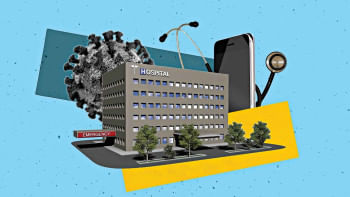Aalo clinics: Changing urban healthcare in Bangladesh

I recently visited the Dhaka Medical College Hospital (DMCH) to conduct a survey for my university coursework. It was essentially my first visit there. My perception of DMCH prior to this visit was that, since it's a government facility, it's not very well-managed, and only gets so many patients because it provides affordable healthcare and related services.
However, only after visiting the place did I realise how dire the situation is at this hospital. It is clearly operating at overcapacity and is burdened with more patients than it can accommodate. Unable to find a bed, sick patients can be seen lying on the floors of corridors and balconies. The agony of those injured or in critical conditions is on open display. I found the overall environment suffocating, and could not help but wonder how the health of a sick individual could improve under such dreadful conditions.
However, we cannot blame the DMCH for this situation. The main reason behind the overcrowding lies elsewhere.
DMCH is a tertiary healthcare facility. That is, the facility's service provision is primarily involved in providing specialised care to patients referred by secondary and primary care facilities. The accepted practice worldwide is, unless it is an emergency, a patient will go to a primary healthcare facility, then get referred to a secondary facility, and eventually a tertiary facility if needed. Yet, a majority of the patients who visit DMCH go there without being referred from the lower-tier healthcare facilities.
Bangladesh became a signatory to the Alma-Ata Declaration in 1978, which means the country is committed to providing primary healthcare. Over the years, despite some setbacks due to the shifting of policies between different governments, Bangladesh has invested significantly in developing its primary healthcare system. For instance, the rural healthcare service delivery system has sound structural design. A hierarchical system is followed, where a patient initially visits a community clinic, then is referred to a union-level health facility, and finally an upazila health complex, depending on their needs.
However, urban areas in Bangladesh don't have a properly defined service delivery system because the health ministry is not responsible for primary healthcare service provision in urban areas. Rather, it is the LGRD ministry's jurisdiction through city corporations and municipalities. However, the LGRD ministry does not have the resources or infrastructure to provide the healthcare services that are required in the urban sphere.
The LGRD ministry currently provides primary care through the Urban Primary Healthcare Services Delivery Project (UPHCSDP) and government dispensaries. However, these healthcare facilities are insufficient in number and cannot cater to the entire urban population. These facilities face various challenges as well, among which are a lack of accountability, weak monitoring system, staff shortages, and provision of limited services. But, most importantly, these facilities are not designed under an umbrella model.
To tackle the existing crises in the provision of primary healthcare in urban areas, Sida of Sweden, Unicef, CMED Health Ltd, and a few other stakeholders recently launched the Urban Clinic Model. The model is currently being operated in six areas under the name "Aalo clinic."
Aalo clinics are designed to provide comprehensive primary healthcare services. The design of this model draws inspiration from Delhi's mohalla clinics, UK's general practitioner (GP) system and a few other countries' primary healthcare systems. The model also addresses the challenges that the existing primary healthcare facilities face, and has designed Aalo clinics in a way to mitigate those problems.
Services at Aalo clinics are provided free of cost and each clinic is expected to have a service coverage of 5,000-6,000 households. The goal is to provide all types of healthcare services, which come under the purview of primary healthcare services such as preventive care, communicable and non-communicable diseases, among others.
An Aalo clinic operates in two shifts of 12 hours each. It houses an adequate number of staff: two GPs (one male and one female), a clinical assistant, a cleaner, and a security guard. The staff is well-trained and doctors are explicitly instructed to see an individual patient for a minimum of 8-10 minutes.
Each facility can provide common diagnostic tests and also telemedicine services. The entire system is digitalised. Therefore, accountability can be ensured through constant monitoring. New patients are also registered in the system's database, for which the doctors will be able to view past records for future visits.
Talks are underway for the government, specifically the health ministry, to take over the project and scale up the model to ensure that there are an adequate number of facilities across all the cities and municipal areas in the country. Implementing such a model, where there are free provisions for healthcare services, and a foolproof system to counter absenteeism, poor quality service, etc, can improve the health of lower-income groups in our urban areas and prevent them from facing catastrophic health expenditures.
If the government can implement the Urban Clinic Model, it is certainly expected to completely change the primary health provision landscape in urban areas, and would significantly reduce the burden on tertiary facilities like the DMCH and other medical colleges. By scaling up the Aalo clinic model, we can go a long way in realising our goal of becoming a country with universal health coverage.
Mohammad Ihtesham Hassan is pursuing a master's degree in health economics at the Institute of Health Economics, Dhaka University.

 For all latest news, follow The Daily Star's Google News channel.
For all latest news, follow The Daily Star's Google News channel. 







Comments